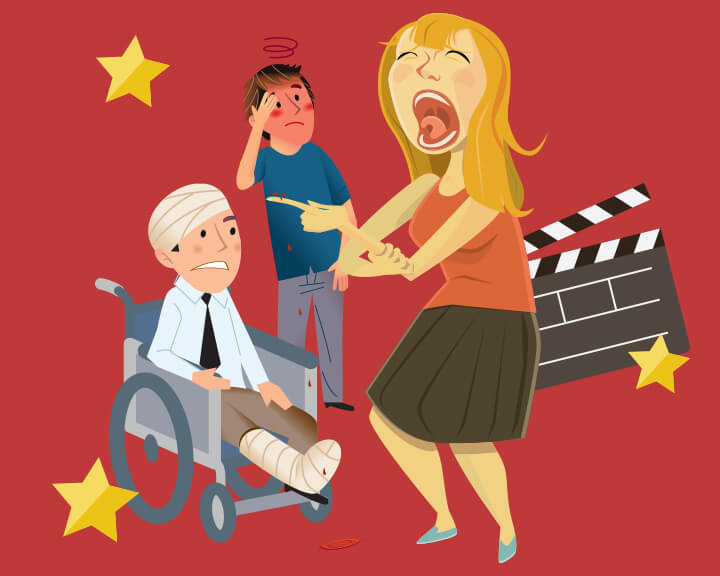Whether posing as a patient reacting to a new medication, a young mother with a sick child, a terrorist in a SWAT exercise, or an overly helpful good Samaritan, simulation actors train people to practice today for tomorrow’s realities.
The demand for actors as trainers continues to grow across the United States, and simulation now takes many forms in the fields of medicine, law enforcement, emergency first response, litigation, business, education and national security. It also offers a steady source of income for trained actors to serve as standardized patients in hospitals, medical schools and health-related educational programs.
“I think simulation is important because it gives acting students a twofold view of their profession,” said Adjunct Associate Professor of Acting Sally Anderson. “First, when they’re going through a simulation, they serve as a tool for someone else. They have to consider the goals and objectives of the person who is hiring them. Second, they learn how to act as characters they may eventually play in a movie or commercial. In that way, it is invaluable training that will help them greatly in their future professions.”
Shenandoah Conservatory students are trained in improvisation, acting, interactive performance, story and technology. This broad-based approach makes them ideally suited to perform in training simulations or in scenarios that require interpersonal interaction.
“Nearly every teaching hospital has a standardized patient unit,” said Anderson. “They pay actors $20 to $60 an hour, depending on the invasiveness of the standardized patient work, from working with medical students gathering physical histories, to psychological, PTSD and grief situations, to teenage traumas.”
Other simulation opportunities include helping lawyers to choose a jury or practice with witnesses; training police units and SWAT teams; providing high-profile business sales training; serving as unruly students for teachers; or acting in living history/museum settings, where Anderson says a majority of students may find jobs after graduation.
The largest opportunity, she said, remains in the area of health care.
INTERPROFESSIONAL LEARNING AND BEYOND
Under Anderson’s leadership, student actors have worked interprofessionally with students in Shenandoah’s School of Health Professions — particularly the physician assistant studies and respiratory care programs — helping to train emerging practitioners.
And the opportunities for collaborative learning through simulation continue to grow. Other academic programs, including psychology, athletic training and nursing, are also calling on Anderson’s students to help provide interprofessional case learning for their students.
To prepare for standardized patient simulations, actors receive a case study with an individual’s medical and social history.
“It’s bare-bones facts, but we get to spice it up and bring it to life,” said senior acting major Lizzie Hinton. “It’s fun because we get to create our own characters based on the facts we’re given.”
According to senior acting major Caleb Forsythe, the rules provided in each case serve as the scaffolding for character development and provide clues for the interviewers.
“It’s actually a very in-depth experience,” he said. “You really have to be ready and on your toes. If you don’t have the history, all the factors as a character in a relationship can’t occur. You have to be aware and fully invested.”
WORKING IN THE COMMUNITY
In addition to simulation patient work, students in Anderson’s class also engage with local community groups.
“We’ve done a lot of training with police,” said Hinton. “Last week, we did a school shooting simulation…with gory makeup, gunshot wounds and broken bones. We were weeping and panicking. It was actually really fun, because it feels like you’re in this dire situation, but in the end, nobody’s really hurt.”
Anne Williams is a lawyer in private practice in Winchester, Virginia, and the Assistant Commonwealth’s Attorney in Clarke County, Virginia. She and Frederick County (Virginia) Assistant Commonwealth’s Attorney Heather Enloe helped Shenandoah acting students to participate in a law firm simulation scenario.
“We arranged for a judge to preside over a mock jury selection,” said Williams. “Once we had selected our ‘jury,’ we had several students leave the courtroom and watch a scene from a movie as if they were eyewitnesses to a criminal act. Those four students were then called into court to testify as if they were witnesses, facing both direct and cross-examination in front of the mock jury.”
At the conclusion of the abbreviated “case,” the jury decided whether the “defendant” was guilty or innocent. Enloe and Williams questioned the students about what they didn’t uncover about their juror characters, how they could have discovered that information better, and whether they picked “good” jurors for their respective cases.
“I believe the students learned a lot about the judicial process, and it was a great tool for Heather and I as lawyers,” said Williams. “Jury selection can be a daunting and intimidating aspect of litigation. However, the more frequently a lawyer can do it, the more comfortable the lawyer will be. Therefore, I feel that using simulation in the legal field for jury selection would benefit many lawyers.”
And what do students think their clients learn from these experiences?
While acting is usually considered an art form, it turns out it is also a great way for actors to serve the communities in which they live.
“I’m going to definitely try to do some simulation work,” said Hinton. “It’s a great way to keep in touch with the community and to help people in a clear-cut way.”
— Contributed by Cathy Loranger
